During the past few months, SIG Sauer, Walther, and Heckler & Koch have introduced pistols that feature striker-fired actions. These handguns are designed to compete for the hearts and minds of institutional buyers and concealed-carry-permit holsters as well. The improvement in rapid-fire combat shooting is provable, and absolute accuracy is improved over the original SIG P250, Walther P99 and HK P30. The question is, which handgun is the most improved and the best buy for the money — that is, the most reliable and accurate?
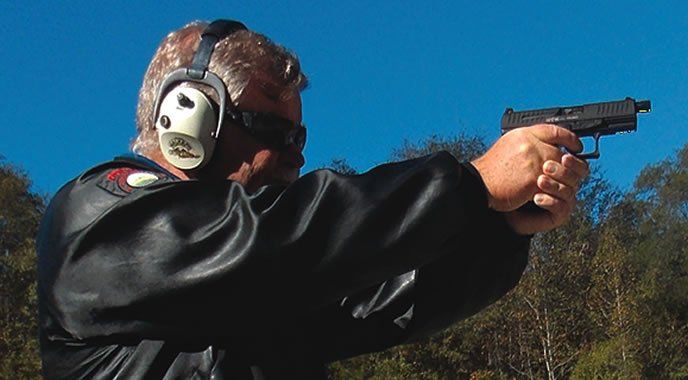
In this test of three 9mm striker-fired models, we were firing handguns intended for personal defense in the home, concealed carry, and practical competition. We are certain each maker is hoping to compete with Glock for institutional sales as well. At first glance, the handguns appeared similar. Each featured a polymer frame, a light rail, and similar sights. Each was relatively simple to operate. None had a manual safety as part of the design. Some features, such as the sights and the magazines, were similar. A casual shooter might sign off on all three handguns, but that isn’t what we do.
Our shooters noticed the trigger actions were markedly different, and grip texturing and handling were considerably different. As the firing sessions progressed and the brass stacked up, the shoot out turned into a strong challenge between the Walther and the HK pistol. These worthy competitors traded places several times in the firing evaluations. The SIG P320 brought up the rear, in our estimation. Here’s why:

SIG Sauer P320 320F9BSS9mm Luger, $579
This was the actual price at CheaperThanDirt.com at the time of our test. The SIG P320 struck a familiar pose. The P320 is an adaptation of the P250 to a striker-fired mechanism. The frame, magazine, and barrel are the same as the P250. Likewise, the P320 is a modular design, so the grip frame and slide may be changed around the serialized metal chassis. The grip frame may also be exchanged for larger or smaller units. A quick search found grip modules at SelwayArmory.com for $40. The test gun came with the medium-grip full-size frame. This grip frame seemed to suit the raters across the board. However, it was as handy or as inexpensive as having the two spare frame inserts supplied with the other handguns. The HK pistol also comes with side panels to modify the grip. There are simply more possibilities for fine tuning hand-to-gun fit with the other makes, we believe.
The SIG weighs 29.5 ounces unloaded, making it the heaviest handgun tested. The slide had a Nitron finish and forward cocking serrations. The serrations offered sufficient purchase for manipulation. The controls included a slide lock, magazine release, and takedown lever. The SIG magazine release was a trapezoidal shape. We had the impression of pressing forward as well as in with this release. It seemed a bit faster than the Walther in use. The HK is much different, with a paddle-type release.
The grip frame was pebbled on the front strap, back strap, and each side in the same pattern. While it featured the lightest texture of the three handguns, it worked OK in helping us hold the gun. There were no finger grooves. This was the largest grip of the three handguns.
The magazine received high marks. Capacity was 17 rounds compared to 15 rounds in the competing pistols. There were grooves in the handle to allow a strong grasp on the magazine in the event it got stuck.
Trigger compression was con-sistent at 7.75 pounds, the heaviest of the three handguns tested. This trigger bears some discussion. While it is called a double-action-only design, it behaves more like a single-action trigger. The striker block moves slightly to the rear as the trigger is pressed, which gives SIG a leg to stand on in terming it a double action. There was no lever in the trigger to prevent lateral discharge.
The sights of the three handguns were equal, as far as sight picture goes. Each was a steel unit with the popular 3-white-dot design. The SIG sights were dovetailed into place front and rear, as were the HK’s sights. The Walther, however, had a staked-on front sight. We prefer the dovetail.
The SIG was supplied with two magazines and a plastic range holster. While not service grade, the holster was an aid on the range. With the other handguns, we were scraping to find a holster during the test period. We were able to use a Hidden Hybrid holster, designed as an IWB, but which has a belt slot for OWB use (HiddenHybridHolsters.com). Molded for the SIG P226, it worked OK for use at the range, but we don’t recommend it for carry.
Prior to range testing, we field-stripped the SIG. Field strip was simple enough, using a takedown lever. The pistol does not have to be decocked for disassembly, a plus in our view. The pistol came with white grease on the rails, so we did not lubricate it further.
We used Federal American Eagle 115-grain FMJ ammunition for our familiarization runs because it’s affordable ($14.49/50 at MidwayUSA.com). We drew the pistol from the supplied holster and fired at man-sized targets at 5, 7, and 10 yards for 100 rounds. The pistol came on target quickly. The slide rode higher above the hand than the other pistols, which limits fast recovery, but a 30-ounce 9mm isn’t difficult to fire and control. Trigger compression was short, which makes up for the 7.75-pound pull weight, to an extent. Trigger travel was about 0.4 inch, and we thought the reset was fast. The pistol performed adequately in the range drills, with no failures to feed, chamber, fire, or eject. The SIG P320 was rated the most comfortable to fire, as far as recoil goes.
In combat drills, the SIG P320 made a good showing. In absolute accuracy, the pistol was limited by the heavy trigger but exhibited an average group size of 2.2 inches at 15 yards with the most accurate load, the Hornady 115-grain XTP. The SIG demonstrated the highest velocity with the Federal American Eagle load and the Federal 147-grain HST +P load used in accuracy work.
Our Team Said: The SIG Sauer P320 is a credible handgun, but we found it lacking in important areas. The trigger is OK for a service pistol, but most of us would like a lighter trigger for better accuracy. But the SIG trigger doesn’t have a safety lever, so it would not be wise to offer a lighter trigger without re-engineering it. The P320 also wasn’t as friendly to diverse hand sizes as were the other guns. Finally, the P320 was the largest and heaviest pistol tested, which works against it as a personal carry sidearm.
Heckler & Koch VP99mm Luger, $630
This was the price of our test gun from TopGunSupply.com at the time of the test. The Heckler & Koch VP9 is based on the HK P30 pistol. The grip frame and magazines are identical. The Heckler & Koch pistol features grip inserts and also side panels, which we rate above the other handguns for versatility.

The pistol’s grip frame fit most hands well, and we found the grip texture to be particularly good. The curve of the grip also fit most hands well. We changed the grip inserts back and forth more with this handgun than the Walther, and found it offers a good range of hand fit. The smallest size and the thinnest panels would be indicated for personal defense and concealed carry use.
The HK VP9 features a striker-fired action, in contrast to the original double-action hammer-fired HK P30. The trigger was pleasant, and light and smooth enough at 6.0 pounds. There was no creep or backlash. Our raters agreed this had the smoothest trigger of the three. The frame was stippled in a crescent pattern on both the front and rear straps and the sides. While similar to the Walther, we rated the Heckler & Koch pistol the better design by a small margin.

Coupled with good hand fit and a lower bore axis than the SIG P320, the pistol felt better in the hands of most testers. On top, the slide was thinner, and the HK pistol featured forward cocking serrations and well defined rear cocking serrations on the slide. A neat touch was the cocking assist blocks in the rear of the slide. They may be removed if desired. For critical use, these cocking assists would allow a trained user to rack the slide with one hand. This would be superior to using the sights for leverage against an object, we feel, and may appeal to the tactically minded shooter.
The Heckler & Koch pistol also featured a red cocking indicator. It was visible at the rear of the slide when the pistol was cocked. The extractor also protruded when the chamber was loaded, giving both a visual and tactile indication of the gun’s status.
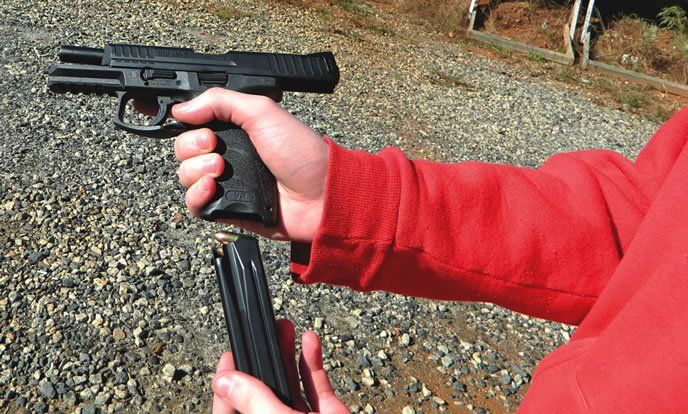
The Heckler & Koch pistol featured good combat sights, each dovetailed in place in the slide. The dots were green in bright light and gave excellent contrast when firing for accuracy. These were the best sights encountered, we felt.
The pistol came with two magazines, both well made. The pistol featured an ambidextrous slide lock that worked well in practice for easy use by right- or left-handed shooters. The sole bone of contention was the magazine release. It was ambidextrous, but functioned differently from the Browning push button we are used to. Our senior rater has considerable experience with another striker-fired HK — the P7M8. He rated the HK magazine release highly, saying it made for a more secure grip and a more secure magazine latch unlikely to be tripped by accident. The rest of the team rated it even with the others. Anyone choosing the HK will be able to quickly acclimate to the magazine latch, we feel, and there are no drawbacks to its operation.
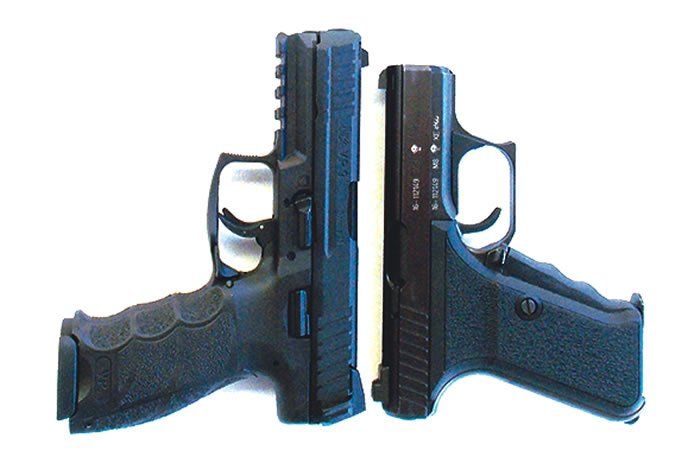
In firing during combat drills, the HK generated more felt recoil than the SIG, but it wasn’t uncomfortable, and it was more comfortable to fire than the Walther. During combat drills, the pistol performed well. The sights were well regulated for 115-grain loads. The pistol’s low bore axis resulted in little muzzle flip. The pistol demonstrated the slowest velocity with three out of four loads clocked. In the HK, the Federal 147-grain HST +P went 1030 fps in the VP9 versus 1020 fps from the Walther.
In bench accuracy, the Heckler & Koch VP9 was the most accurate pistol. It shot the tightest group, a 1.7-inch cluster fired with the Hornady 115-grain XTP.
Our Team Said: The Heckler & Koch VP9 9mm has the best combination of features for personal defense in this trio. The trigger action, sights, the grip frame’s range of adjustment, and the feel going to and engaging targets make it the best gun in this test, we believe.
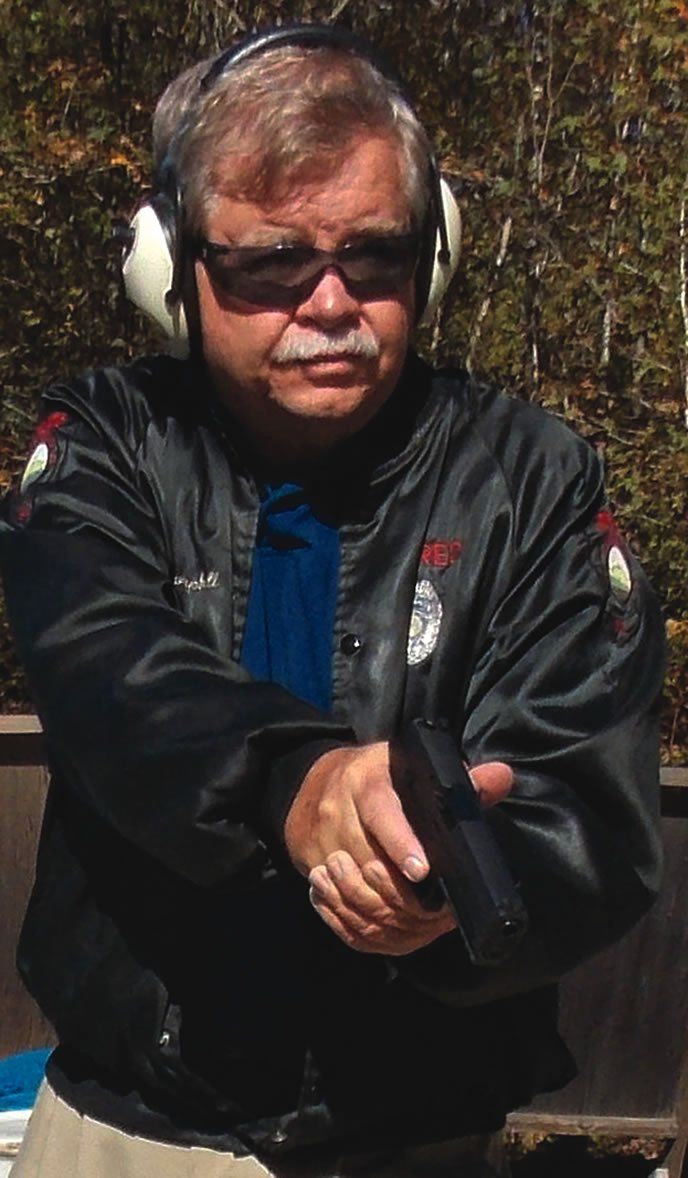
Walther PPQ M2 Navy SD2796082 9mm Luger, $576
The model with an unthreaded barrel was $531 at CheaperThanDirt.com, but we tested a slightly more expensive threaded-barrel gun for $576. Even so, the Walther was the least expensive handgun tested. The Walther was similar to the other handguns in that it featured forward cocking serrations and a light rail. The pistol breaks down differently, however, by using two levers in front of the trigger guard. Field stripping wasn’t a problem, we found.
The trigger was similar to the HK’s; however, compression was lighter at 5.4 pounds. When working with this trigger, one of our raters came straight off the SIG and its 7.75-pound trigger. He double-tapped the Walther when he did not intend to. The Walther trigger was lighter, and like any trigger, it must be mastered if the handgun is carried for personal defense. We found the trigger to be controllable, and it offered good combat accuracy. All raters said that it felt lighter than it actually registered on the trigger gauge.
The grip frame was roughened for adhesion similar to the HK. However, in addition to finger grooves on the front strap, this pistol also featured raised areas on each side of the grip. While some raters were neutral on this feature, others did not like this.
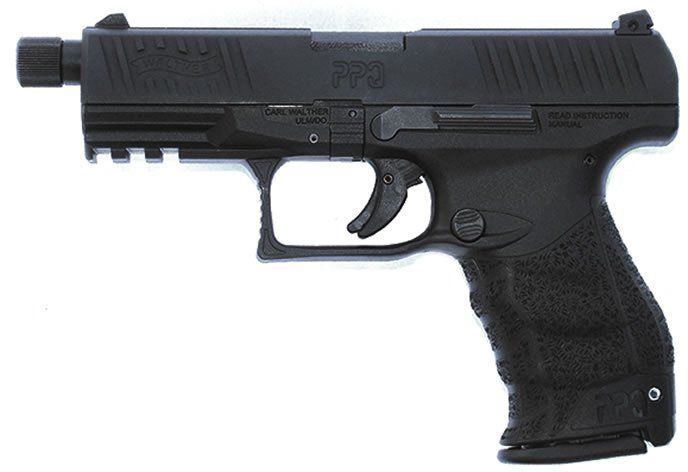
The Walther was supplied with two magazines. They hold the same 15 rounds as the HK, but one of the Walther magazines featured a bumper pad or finger extension. It does not increase capacity, but it bulks the gun up. Only the largest hands would find it beneficial. The Walther uses a reversible button-style mag release. The pressure required to activate this release is lighter than the SIG. However, there were no inadvertent magazine-release incidents. Still, the raters agreed that the magazine release was too light for a service or personal-defense handgun.
The Walther’s sights were different. They were not mounted in dovetail slots in the manner of the other handguns we tested. The front was a post, and the rear, interestingly, was adjustable for windage with a set screw. During the testing, the 147-grain load fired high, which was expected, but the 115-grain +P load also fired high, as did the generic 115-grain ball load. The other handguns did not fire high. The Walther shot well in combat drills, but all commented that the PPQ M2 exhibited the hardest felt recoil. This was most noticeable with the Federal 147-grain HST +P loading.
Our Team Said: On the upside, the Walther PPQ M2 never failed to feed, chamber, fire, or eject. It was a reliable handgun. The sights were different, but usable. We did not like the magazine release; in our opinion, it needs to be tighter. Also, the trigger wasn’t ideal for personal defense.
Written and photographed by R.K. Campbell, using evaluations from Gun Tests team testers.

























